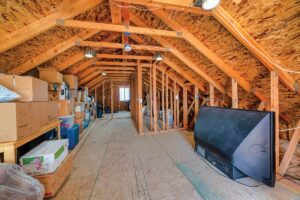 To answer the question how much ventilation is enough, we first need to understand why we need ventilation. Just to be clear, the “ventilation” I am referring to is mechanical ventilation. Although, opening a window is ventilation as well.
To answer the question how much ventilation is enough, we first need to understand why we need ventilation. Just to be clear, the “ventilation” I am referring to is mechanical ventilation. Although, opening a window is ventilation as well.
Mechanical ventilation would include your bathroom exhaust fan and kitchen range hood. We call this local ventilation, removing moisture and pollutants at the source. To include the kitchen range hood as a mechanical ventilation device it must be ducted to the outside. There are three ventilation strategies: Exhaust – fans that move air from inside the home to the outside. Supply – fans that move air from the outside into the home. Balanced – exhausting and supplying air at the same time and rate. Therefore, the kitchen range hood that blows hot greasy air into your face is not ventilation.
We need ventilation to maintain good indoor air quality (IAQ). There are many pollutants in our homes and we bring more into our homes every day. Many we can smell and can open the windows to get rid of the smell. Once the smells are gone, we close the windows. That’s what we do with mechanical ventilation. Before we get into the shower, we turn on the exhaust fan to remove the moisture. Makes sense.
There are chemicals that we cannot detect and can be harmful to our health. VOC’s (volatile organic compounds) usually come from new products that off gas sometimes for years, like new carpet, paint, laminate countertops, furniture, clothes, laundry detergent and fabric softener. And don’t even get me started on those squirt into the air or plug into the wall to make your house smell better air fresheners! Really! Not to mention burning candles. We need mechanical ventilation to protect us from us!
I have been called to homes where people could not stay in the home because of the excessive VOC concentration. Their eyes would water and their noses would run. Seven years ago this happened to me with an enclosed trailer I bought. I owned it for four years before I could be in the trailer for more than a minute without my eyes and nose running. It took that long for the plywood inside the trailer to off gas enough that it wouldn’t bother me.
We breathe in oxygen and exhale carbon dioxide. Where does it go? Researchers have found that when we get several people into a room the carbon dioxide goes up and the oxygen goes down. We get a little sleepy, maybe a small headache and thinking becomes more difficult due to the lack of oxygen to the brain. How many times have you said that you were going to get some fresh air? That was your body telling you it needs a little help. Getting out of that high carbon dioxide and low-level oxygen environment wakes you up and you start thinking more clearly.
How much ventilation is enough? You need as much ventilation as necessary to remove the buildup of contaminates and moisture from the home, but not too much to increase your energy costs. There are people that think, “if a little is good, a lot should be better.” Not with ventilation. We need good indoor quality for maintaining our family’s health. That is our first priority. However, over ventilating is not bad for our health, but it comes at the cost of higher utility bills. You are always better off to have a tighter home, and have a good planned and measured ventilation strategy, than to have a home that is drafty and self-ventilating.
Ventilation tips:
• Eliminate any source of excess moisture or contaminates.
• Run your bath fan for at least another 30 minutes after leaving the bathroom.
• If you have excessive condensation on your windows in the winter, you have a ventilation problem, not a window problem.
• When you operate your stove or oven, turn on your range hood exhaust fan or open a window.

• If you are still having ventilation related issues, have someone do a blower door test to measure how tight your home is and measure the flow through all exhaust fans. The tighter the home is, the more important mechanical ventilation becomes!
I have been writing the Energy Solutions article for a little over a year now. In almost every article I mention ventilation. Ventilation is very important and often misunderstood in the building community. It is not expensive, complicated or difficult to install. I can tell you this, every failed home I have gone to due to excess moisture or poor indoor air quality, the lack of mechanical ventilation was a significant contributing factor.









